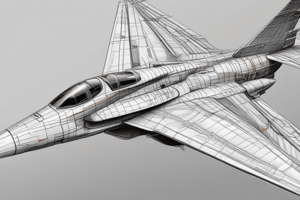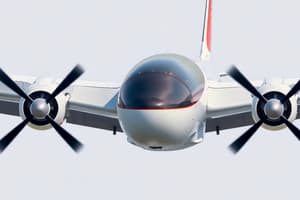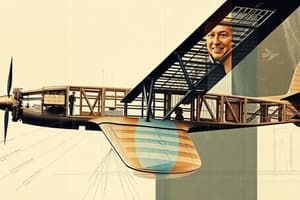Podcast
Questions and Answers
Các bộ phận cấu thành cơ bản của máy bay đủ để đánh giá phối trí khí động của nó gồm
Các bộ phận cấu thành cơ bản của máy bay đủ để đánh giá phối trí khí động của nó gồm
- Cánh, thân, cánh đuôi, các cánh lái.
- Thân, cánh, các cánh lái.
- Cánh, thân, cánh đuôi. (correct)
- Các phương án đều đúng.
Phối trí khí động của máy bay dạng kinh điển là phối trí
Phối trí khí động của máy bay dạng kinh điển là phối trí
- "Có đuôi ngang đặt trước cánh nâng . "
- Có đuôi ngang đặt sau cánh nâng. (correct)
- Không cần đuôi ngang.
- Các phương án đều sai.
Cánh tà của máy bay có công dụng
Cánh tà của máy bay có công dụng
- Tạo các moment điều khiển.
- Thiết bị tăng khả năng tạo lực nâng. (correct)
- Làm tăng tính ổn định dọc của máy bay.
- Các phương án đều đúng.
Các phản ứng của máy bay khi thả cánh tà sau
Các phản ứng của máy bay khi thả cánh tà sau
Các lực tác dụng vào máy bay khi bay gồm có?
Các lực tác dụng vào máy bay khi bay gồm có?
Lực nâng của cánh máy bay không phụ thuộc vào yếu tố nào sau đây?
Lực nâng của cánh máy bay không phụ thuộc vào yếu tố nào sau đây?
Có thể giải thích cơ chế tạo ra lực nâng trên cánh máy bay bằng?
Có thể giải thích cơ chế tạo ra lực nâng trên cánh máy bay bằng?
Hiện tượng thất tốc (stall) của máy bay là hiện tượng?
Hiện tượng thất tốc (stall) của máy bay là hiện tượng?
Lực cản của máy bay là?
Lực cản của máy bay là?
Lực cản của từng thành phần (cánh, giá động cơ và động cơ) có giá trị lần lượt là (700N, 50N, 150N). Lực cản tổng có giá trị là bao nhiêu?
Lực cản của từng thành phần (cánh, giá động cơ và động cơ) có giá trị lần lượt là (700N, 50N, 150N). Lực cản tổng có giá trị là bao nhiêu?
Flashcards
Aircraft's Basic Components
Aircraft's Basic Components
The fundamental parts of an aircraft that determine its aerodynamic arrangement are the wings, fuselage, and tail.
Classic Aircraft Configuration
Classic Aircraft Configuration
The standard configuration of a plane features a horizontal tail placed behind the main wing for stability.
Aileron Function
Aileron Function
Ailerons are movable control surfaces on the wings that increase lift on one side and decrease it on the other, allowing the plane to roll.
Effects of Deploying Ailerons
Effects of Deploying Ailerons
Signup and view all the flashcards
Forces Acting on a Flying Aircraft
Forces Acting on a Flying Aircraft
Signup and view all the flashcards
Factors Not Affecting Wing Lift
Factors Not Affecting Wing Lift
Signup and view all the flashcards
Mechanism of Generating Lift
Mechanism of Generating Lift
Signup and view all the flashcards
Aircraft Stall
Aircraft Stall
Signup and view all the flashcards
Aircraft Drag
Aircraft Drag
Signup and view all the flashcards
Total Drag Calculation
Total Drag Calculation
Signup and view all the flashcards
Study Notes
Basic Components of an Airplane
- The basic components of an airplane that affect its aerodynamic configuration are the wings, fuselage, and tail.
Functions of an Airplane's Wing
- The wing of an airplane has the function of producing lift.
Effects of Deploying an Airplane's Flaps
- After deploying an airplane's flaps, the airplane will experience certain reactions.
Forces Acting on an Airplane in Flight
- The forces acting on an airplane in flight include lift, weight, thrust, and drag.
Independence of Lift Force
- The lift force of an airplane's wing does not depend on the weight of the airplane.
Explanation of Lift Generation
- The mechanism of lift generation on an airplane's wing can be explained by Bernoulli's principle.
Stalling of an Airplane
- Stalling of an airplane is a phenomenon where the wing's lift suddenly decreases.
Drag Force
- Drag is a force that opposes an airplane's motion.
Total Drag Force Calculation
- The total drag force is the sum of the drag forces of individual components, which in this case is 700N + 50N + 150N = 900N.
Studying That Suits You
Use AI to generate personalized quizzes and flashcards to suit your learning preferences.



